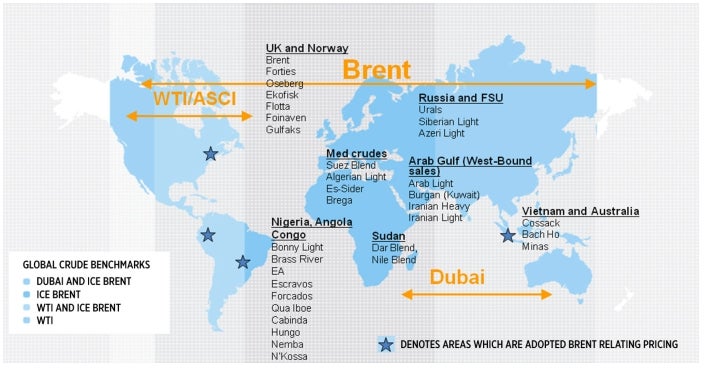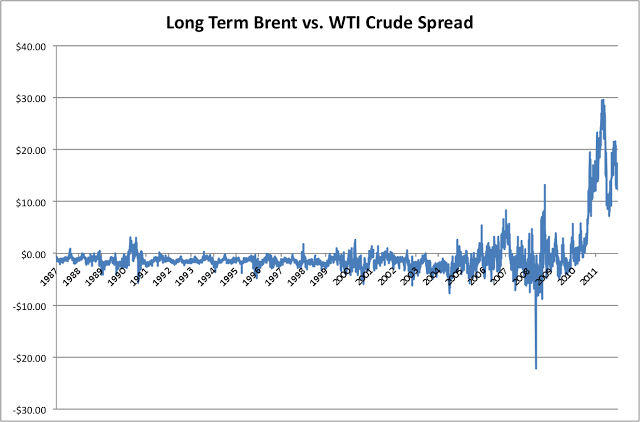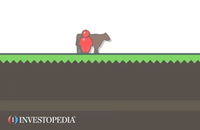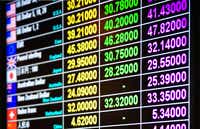Open a newspaper and there’s a good chance you’ll find a news story about the price of oil going one direction or the other. To the average consumer, it’s easy to get the impression that there’s a singular, worldwide market for this crucial energy source.
In reality, there are different types of crude oil – the thick, unprocessed liquid that drillers extract below the earth – and some are more desirable than others. For instance, it’s easier for refiners to make gasoline and diesel fuel out of low-sulfur, or “sweet,” crude than oil with high sulfur concentrations. Low-density, or “light,” crude is generally favorable to the high-density variety for the same reason.
Where the oil comes from also makes a difference if you’re a buyer. The less expensive it is to take delivery of the product, the more you’re willing to pay for it. From a transportation standpoint, oil extracted at sea has certain advantages over land-based supplies, which depend on the capacity of pipelines.
Because of these nuances, buyers of crude oil – along with speculators who will never actually take delivery of it – need an easy way to value the commodity based on its quality and location. Benchmarks such as Brent, WTI and Dubai/Oman serve this important purpose. When refiners purchase a Brent contract, they have a good idea of how good the oil will be and where it will come from. Today, much of the global trading takes place on the futures market, with each contract tied to a certain category of oil.
Because of the dynamic nature of supply and demand, the value of each benchmark is continually changing. Over the long-term, a marker that sold at a premium to another index may suddenly become available at a discount.
The main benchmarks
There are literally dozens of different oil benchmarks, with each one representing crude oil from a particular part of the globe. However, the price of most of them are pegged to one of three primary benchmarks:
- Brent Blend – Roughly two-thirds of all crude contracts around the world reference Brent Blend, making it the most widely used marker of all. These days, “Brent” actually refers to oil from four different fields in the North Sea: Brent, Forties, Oseberg and Ekofisk. Crude from this region is light and sweet, making them ideal for the refining of diesel fuel, gasoline and other high-demand products. And because the supply is water-borne, it’s easy to transport to a distant locations.
- West Texas Intermediate (WTI) – WTI refers to oil extracted from wells in the U.S. and sent via pipeline to Cushing, Oklahoma. The fact that supplies are land-locked is one of the drawbacks to West Texas crude – it’s relatively expensive to ship to certain parts of the globe. The product itself is very light and very sweet, making it ideal for gasoline refining, in particular. WTI continues to be the main benchmark for oil consumed in the United States. (Read, A Look at The U.S. Shale Oil Production Industry.)
- Dubai/Oman – This Middle Eastern crude is a useful reference for oil of a slightly lower grade than WTI or Brent. A “basket” product consisting of crude from Dubai, Oman or Abu Dhabi, it’s somewhat heavier and has higher sulfur content, putting it in the “sour” category. Dubai/Oman is the main reference for Persian Gulf oil delivered to the Asian market.
Figure 1
Brent is the reference for about two-thirds of the oil traded around the world, with WTI the dominant benchmark in the U.S. and Dubai/Oman influential in the Asian market.

Source: IntercontinentalExchange (ICE)
Importance to futures market
There was once a time when buyers would primarily purchase crude oil on the “spot market” – that is, they’d pay the current price and accept delivery within a few weeks. But after the oil crisis of the late 1970s, refiners and government buyers began looking for a way to minimize the risk of sudden price increases.
The solution came in the form of the crude oil futures, which are tied to a specific benchmark crude. With futures, buyers can lock in the price of a commodity several months, or even years, in advance. If the price of the reference crude rises significantly, the purchaser is better off with the futures contract. Many futures are settled in cash, although some allow for physical delivery of the commodity.
Different crude contracts trade on different exchanges. Brent futures are available on ICE Futures Europe, while WTI contracts are sold chiefly on the New York Mercantile Exchange, or NYMEX. The influential Oman Crude Oil Futures Contract (DME Oman) has been marketed on the Dubai Mercantile Exchange since 2007. These contracts stipulate not only where the oil is drilled, but also its quality.
Crude options
In addition to futures, market participants can also invest in options that are linked to a particular crude benchmark. These derivatives are another important way to help mitigate price risk. Should the value of a certain crude marker skyrocket, the owner of a call option would have the right – though not the obligation – to buy a specific number of barrels at a pre-determined price.
However, not all options tied a crude benchmark are used for hedging purposes. Speculators are also major players in the market, betting that changes to supply or demand will drive the price of certain crude products higher or lower.
Investors can also gamble on the what will happen to the difference, or spread, between two benchmarks. Participants typically analyze the fundamentals of a specific oil source and guess whether the gap between two markers will widen or close. Like traditional oil options, these “spread options” are available on major exchanges.
Trading tends to be particularly heavy when one of the two benchmarks undergoes unusual volatility. For example, WTI-Brent spread options on NYMEX experienced record trading volume from 2011 to 2013 after a glut in U.S. crude sent WTI prices in a tailspin relative to Brent.
Figure 2
The following chart shows the Brent-WTI spread. The historic closeness between the two markers changed in 2011, the result of a surplus in stored oil at Cushing, Oklahoma.

Source: Avondale Asset Management
The Bottom Line
The market for crude is incredibly diverse, with the quality and original location of the oil making a major impact on price. Because they’re relatively stable, most crude oil prices worldwide are pegged to the Brent, WTI or Dubai/Oman benchmarks.
-
 Economics
EconomicsWill Winter Affect the Price of Oil and Gas?
Learn how heating oil and natural gas prices are affected during a harsh or mild winter and the EIA's prediction for heating consumption. -
 Stock Analysis
Stock AnalysisDeepwater Explorations That Had Profitable Results
Learn how deepwater oil wells sometimes deliver large profits to the companies finding them, if the oil company drillers can overcome high fixed costs. -
 Chart Advisor
Chart AdvisorCopper Continues Its Descent
Copper prices have been under pressure lately and based on these charts it doesn't seem that it will reverse any time soon. -
 Economics
EconomicsThe Biggest Oil Towns in Texas
Learn about the boom of oil production in Texas cities and how the new surge of wealth into these cities is changing local economies. -
 Stock Analysis
Stock AnalysisWhat Exactly Does Warren Buffett Own?
Learn about large changes to Berkshire Hathaway's portfolio. See why Warren Buffett has invested in a commodity company even though he does not usually do so. -
 Stock Analysis
Stock AnalysisWhat Chevron Hopes to Find in its Exploration of the Great Australian Bight
Learn about Chevron's agreements that allow the oil company to explore the Great Australian Bight and the state of current Australian oil projects. -
 Economics
EconomicsThe Difference Between Finance And Economics
Finance and economics are often taught as separate subjects, but they are interrelated disciplines that influence one another in many ways. -
 Economics
EconomicsUnderstanding Tragedy of the Commons
The tragedy of the commons describes an economic problem in which individuals try to reap the greatest benefits from a given resource. -
 Markets
MarketsAre EM Stocks Finally Emerging?
Many investors are looking at emerging market (EM) stocks and wonder if it’s time to step back in, while others wonder if we’ll see further declines. -
 Markets
MarketsWhat Slow Global Growth Means for Portfolios
While U.S. growth remains relatively resilient, global growth continues to slip.
-
Is Norway a developed country?
Norway is a highly developed country, and typically has a world GDP ranking in the top 30, with a 2014 GDP at $500 million ... Read Full Answer >> -
Is Chile a developed country?
As of 2015, Chile is the only country in Latin America that is generally recognized as a developed country. In 2010, the ... Read Full Answer >> -
Is Nigeria a developed country?
Nigeria is not a developed country by any reasonable standard. The country's per capita gross domestic product (GDP) is much ... Read Full Answer >> -
Is Qatar a developed country?
Qatar is a developing country, according to the United Nations. However, as the country with the highest gross domestic product ... Read Full Answer >> -
Which mutual funds made money in 2008?
Out of the 2,800 mutual funds that Morningstar, Inc., the leading provider of independent investment research in North America, ... Read Full Answer >> -
Why do some oil refineries get tax exemptions?
Oil refineries normally receive tax exemptions due to tax loopholes. The extracted fuel exemption, for example, one of the ... Read Full Answer >>
 Free Annual Reports
Free Annual Reports